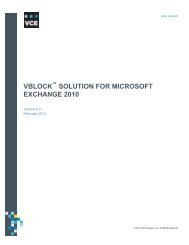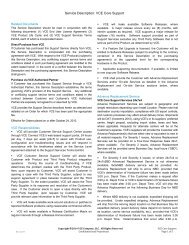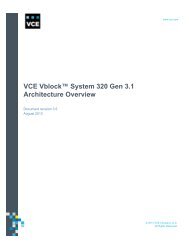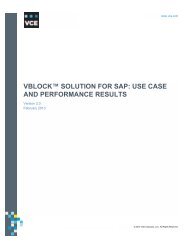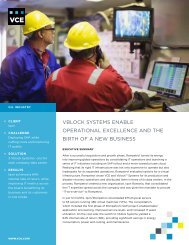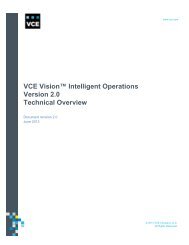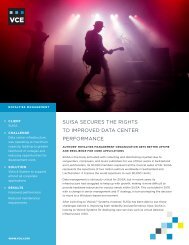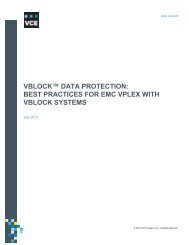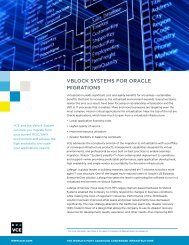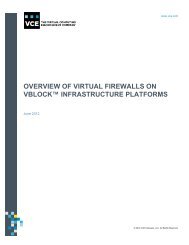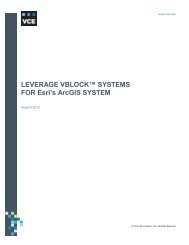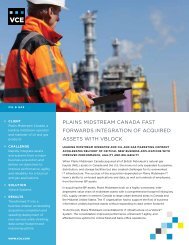SAP OS/DB Migration from HP-UX Platform to Vblock Systems - VCE
SAP OS/DB Migration from HP-UX Platform to Vblock Systems - VCE
SAP OS/DB Migration from HP-UX Platform to Vblock Systems - VCE
Create successful ePaper yourself
Turn your PDF publications into a flip-book with our unique Google optimized e-Paper software.
Introduction<br />
This document describes best practices for the operating system and database migration of <strong>SAP</strong> <strong>from</strong><br />
<strong>HP</strong> Integrity Superdome servers running PA-RISC/<strong>HP</strong>-<strong>UX</strong> <strong>to</strong> <strong>Vblock</strong> <strong>Systems</strong> running x86 Red Hat<br />
Enterprise Linux. This paper demonstrates how cus<strong>to</strong>mers can lower the migration risk of moving<br />
<strong>from</strong> a physical environment running <strong>HP</strong>-<strong>UX</strong> <strong>to</strong> <strong>Vblock</strong> <strong>Systems</strong> running Red Hat Linux in a virtualized<br />
environment.<br />
Traditional infrastructure practices recommend sizing for the worst case, which is an inefficient<br />
approach that adds <strong>to</strong> business risk. With <strong>Vblock</strong> <strong>Systems</strong>, cus<strong>to</strong>mers can plan for the optimum size<br />
and take advantage of the dynamic scalability for <strong>SAP</strong> <strong>to</strong> support the worst-case scenarios.<br />
This paper provides guidance and testing results <strong>from</strong> a proof of concept (POC) performed for a large<br />
semiconduc<strong>to</strong>r equipment manufacturing company. The company’s <strong>SAP</strong> landscape includes the<br />
following modules: Enterprise Resource Planning (ERP), Supply Chain Management (SCM), Supplier<br />
Relationship Management (SRM), Business Intelligence (BI), Process Integration (PI), and Enterprise<br />
Portal (EP). The tests involved migration and performance of two core <strong>SAP</strong> modules, ERP SCM and<br />
liveCache. <strong>Vblock</strong> System 700 was used as the target environment for this migration.<br />
Business case<br />
Virtualization has rapidly gained momentum in enterprise IT environments, because organizations are<br />
looking for ways <strong>to</strong> control escalating hardware costs and <strong>to</strong> optimize their use of energy and<br />
resources while improving business continuity. Virtualization of complex <strong>SAP</strong> applications can reduce<br />
costs and increase speed and resilience. Virtualization also permits faster data analysis and expands<br />
data analysis capabilities.<br />
Key results<br />
Key results demonstrate that when deployed on the <strong>Vblock</strong> System 700, <strong>SAP</strong> showed performance<br />
improvement well over the incumbent hardware. The key findings are:<br />
§ Performance improvement of 50% or more when running <strong>SAP</strong> on the <strong>Vblock</strong> System 700<br />
compared with a semiconduc<strong>to</strong>r equipment manufacturer’s environment<br />
§ 50% less hardware used compared <strong>to</strong> the cus<strong>to</strong>mer’s environment<br />
§ Low migration risk moving <strong>from</strong> an <strong>HP</strong>-<strong>UX</strong> based physical environment <strong>to</strong> a <strong>Vblock</strong> System 700<br />
virtualized environment<br />
§ Fast recovery of failed application and database server blades with EMC Ionix Unified<br />
Infrastructure Manager (UIM) and Cisco Unified Computing System (UCS) service profiles<br />
§ Increased scalability <strong>to</strong> dynamically add resources<br />
§ High availability and live migration achieved through VMware vMotion<br />
© 2013 <strong>VCE</strong> Company, LLC. All Rights Reserved.<br />
6



